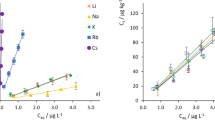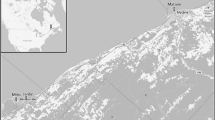Abstract
This study focused on the sorption isotherms of 1,1,1-trichloro-2,2-bis(p-chlorophenyl) ethane (p,p′-DDT) and 1,1-dichloro-2,2-bis(p-chlorophenyl) ethylene (p,p′-DDE) on different original clays (i.e., zeolite, montmorillonite and attapulgite) and organoclay complexes. Sorption of organic pollutants was determined using gas chromatographic (GC) techniques to investigate the sorption behavior, and characterize the effect of, different organic cations. The original clays only sorbed low amounts of p,p′-DDT and p,p′-DDE, and the sorptive curves can be classified as L-shaped. Organoclays exhibited higher amounts of p,p′-DDT and p,p′-DDE sorption. The p,p′-DDT and p,p′-DDE sorption increased with increasing total organic carbon (OC) content of the organoclays. For hexadecyltrimethylammonium (HDTMA)-modified organoclays, the dominant adsorptive medium showed the partitioning sorption of hydrophobic–hydrophobic interaction, indicating no competitive sorption. The sorptive curves can be classified as C-shaped of constant partition (CP). However, benzyltrimethylammonium (BTMA)-modified organoclays exhibited competitive sorption. The sorption isotherm curves can be classified as S-shaped. The sorptive capacity of the HDTMA-modified organoclays for p,p′-DDT were higher than those for p,p′-DDE, but the BTMA-modified organoclays showed a reverse trend. This can be attributed to the different structures and shapes of organic cations, giving different sorptive mechanisms. The p,p′-DDT and p,p′-DDE sorption onto HDTMA-modified organoclays were caused by chemical interaction, with the BTMA modified organoclays occuring due to physical sorption.





Similar content being viewed by others
References
Allred, B., & Brown, G. O. (1994). Surfactant-induced reductions in soil hydraulic conductivity. Ground-Water Management Research Spring, 15, 174–184.
Andrade, M. L., Reyzabal, M. L., Covelo, E. F., & Vega, F. A. (2005). Organochlorine pesticides in soils of the horticultural belt of Bahia Blanca (Argentina). Canadian Journal of Soil Science, 85, 273–282.
Beck, A. J., Johnston, A. E. J., & Jones, K. C. (1993). Movement of noionic organic chemicals in agricultural region. Critical reviews in Environment Science Technology, 23, 248–319.
Binelli, A., & Provini, A. (2003). DDT is still a problem in developed countries: The heavy pollution of Lake Maggiore. Chemosphere, 52, 717–723.
Chen, L. G., Ran, Y., Xing, B. S., Mai, B. X., He, J. H., Wei, X. G., Fu, J. M., & Sheng, G. Y. (2005). Contents and sources of polycyclic aromatic hydrocarbons and organochlorine pesticides in vegetable soils of Guangzhou, China. Chemosphere, 60, 879–890.
Gao, H. J., Jiang, X., Wang, F., Bian, Y. R., Wang, D. Z., Deng, J. C., & Yan, D. Y. (2005). Residual levels and new inputs of chlorinated POPs in agricultural soils from Taihu Lake region. Pedosphere, 15, 301–309.
Giesy, J. P., & Kannan, K. (2001). Global distribution of perfluorooctane sulfonate in wildlife. Environmental Science Technology, 35, 1339–1342.
Giles, C. H., DSilva, A. P., & Easton, I. A. (1974). A general classification of the solute adsorption isotherms. Journal of Colloid and Interface Science, 47, 766–789.
Giles, C. H., MacEwan, T. H., Nakhwa, S. N., & Smith, D. (1960). Studies in sorption part XI. A system of classification of solution adsorption isotherms. Journal of Chemical Society, 786, 3373–3380.
Hermosín, M. C., Celis, R., Facenda, G., Carrizosa, M. J., Ortega-Calvo, J. J., & Cornejo, J. (2006). Bioavailability of the herbicide 2,4-D formulated with organoclays. Soil Biology & Biochemistry, 382, 117–2124.
Hsu, Y. H., Wang, M. K., Pai, C. W., & Wang, Y. S. (2000). Sorption of 2,4-dichlorophenoxy propionic acid by organo-clay complexes. Applied Clay Science, 16, 147–159.
Jaynes, W. F., & Boyd, S. A. (1991). Clay mineral type and organic compound sorption by hexadecyltrimethylammonium-exchanged clays. Soil Science Society America Journal, 55, 43–48.
Klumpp, E., Contreras-Ortega, C., & Klahre, P. (2004). Sorption of 2,4-dichlorophenol on modified hydrotalcites. Colloids and Surfaces A: Physicochemical Engineering Aspects, 230, 111–116.
Kosubova, P., Grabic, R., & Holoubek, I. (2005). Toxaphen and other chlorinated pesticides in the Czech mountain and lowland forest ecosystems. Fresenius Environmental Bulletin, 14, 160–166.
Liao, C. J., Chen C. P., Wang, M. K., Chiang, P. N., & Pai, C. W. (2006). Sorption of chlorophenoxy propionic acid by organoclay complexes. Environmental Toxicology, 21, 71–79.
Nkedi, K. P., Rao, P. S. C., & Hornsby, A. G. (1985). Influence on organic cosolvents on sorption of hydrophobic organic chemicals by soils. Environment Science Technology, 19, 975–979.
Nzengung, V. A., Voudrias, E. A., Nkedi-Kizza, P., Wampler, J. M., & Weaver, C. E. (1996). Organic cosolvent effects on sorption equilibrium of hydrophobic organic chemicals by organoclays. Environmental Science Technology, 30, 89–96.
Oyanedel-Craver, V. A., Fuller, M., & Smith, J. A. (2006). Simultaneous sorption of benzene and heavy metals onto two organoclays. Journal of Colloid and Interface Science, 309, 485-492.
Özcan, A., Ömeroğlu, Ç., Erdoğan, Y., & Özcan, A.Safa. (2006). Modification of bentonite with a cationic surfactant: An adsorption study of textile dye Reactive Blue 19. Journal of Hazardous Materials, 140, 173–179.
Pernyeszi, T., Kasteel, R., Witthuhn, B., Klahre, P., Vereecken, H., & Klumpp, E. (2006). Organoclays for soil remediation: Adsorption of 2,4-dichlorophenol on organoclay/aquifer material mixtures studied under static and flow conditions. Applied Clay Science, 32, 179–189.
Redding, A. Z., Burns, S. E., Upson, R. T., & Anderson, E. F. (2002). Organoclay sorption of benzene as a function of total organic carbon content. Journal of Colloid and Interface Science, 250, 261–264.
Richard, W. G., Walter, J., & Weber. J. R. (2001). Evaluation of shale and organoclays as sorbent additives for low-permeability soil containment barriers. Environmental Science Technology, 35, 1523–1530.
Seki, Y., & Yurdakoc, K. (2005). Paraquat adsorption onto clays and organoclays from aqueous solution. Journal of Colloid and Interface Science, 287, 1–5.
Shen, G. Q., Lu, Y. T., Wang, M. N., & Sun, Y. Q. (2005). Status and fuzzy comprehensive assessment of combined heavy metal and organo-chlorine pesticide pollution in the Taihu Lake region of China. Journal of Environmental Management, 76, 355–362.
Shi, Y., Meng, F., Guo, F., Lu, Y., Wang, T., & Zhang, H. (2005). Residues of organic chlorinated pesticides in agricultural soils of Beijing, China. Archives of Environmental Contamination and Toxicology, 49, 37–44.
Shu, Y. H., & Jia, X. S. (2005). The mechanisms for CTMAB-bentonites to adsorb CBs from water in the adsorption kinetics and thermodynamics view. Acta Scientiae Circumstantiae, 25, 1530–1536.
Smith, J. A., & Galan, A. (1995). Sorption of nonionic organic contaminants to single and dual organic cation bentonites from water. Environmental Science Technology, 29, 685–692.
Smith, J. A., Jaffe, P. R., & Chiou, C. T. (1990). Effect of ten quaternary ammonium cations on tetrachloromethane sorption to clay from water. Environmental Science Technology, 24, 1167–1172.
Socias-Viciana, M. M., Hermosin, M. C., & Cornejo, J. (1998). Removing prometrone from water by clays and organoclays. Chemosphere, 37, 289–300.
Sui, H., Li, X. G., Huang, G. Q., Zhang, Y., & Gao, X. F. (2003). The in-situ remediation technologies for soils contaminated by organic chemicals. Techniques and Equipment for Environmental Pollution Control, 4, 41–45.
Tao, S., Xu, F. L., Wang, W. J., Liu, W. X., Gong, Z. M., Zhu, L. Z., & Luo, Y. M. (2005). Organochlorine pesticides in agricultural soil and vegetables from Tianjin, China. Environmental Science Technology, 39, 2494–2499.
Upson, R. T., & Burns, S. E. (2006). Sorption of nitroaromatic compounds to synthesized organoclays. Journal of Colloid and Interface Science, 297, 70–76.
Wang, X. R., Wu, S. N., & Li, W. S. (1997). Contaminated environment remediation with organoclay minerals. Environmental Chemistry, 16, 1–14.
Wiles, M. C., Huebner, H. J., McDonald, T. J., Donnelly, K. C., & Phillips, T. D. (2005). Matriximmobilized organoclay for the sorption of polycyclic aromatic hydrocarbons and pentachlorophenol from groundwater. Chemosphere, 59, 1455–1464.
Yasser, Z. El-N., & Jamal, M. S. (2004). Adsorption of phenanthrene on organoclays from distilled and saline water. Journal of Colloid and Interface Science, 269, 265–273.
Zhang, H., Lu, Y. L., Dawson, R. W., Shi, Y. J., & Wang, T. Y. (2005). Classification and ordination of DDT and HCH in soil samples from the Guanting Reservoir, China. Chemosphere, 60, 762–769.
Zhao, B. Z., Zhang, J. B., Zhou, L. Y., Zhu, A. N., Xia, M., & Lu, X. (2005). Residues of HCH and DDT in typical agricultural soils of Huang-Huai-Hai plain, China: Residues in surface soils and their isomeric composition. Acta Pedologica Sinica, 42, 761–768.
Zhou, Q., Frost, R. L., He, H. P., & Xi, Y. F. (2006). Changes in the surfaces of adsorbed para-nitrophenol on HDTMA organoclay. The XRD and TG study. Journal of Colloid and Interface Science, 307, 50–55.
Zhu, L. Z., Ma, D. D., & Chen, B. L. (2000). Sorption properties and mechanisms of phenanthrene to dual-cation organobentonites. Environmental Chemistry, 19, 256–261.
Acknowledgements
We thank the National Key Basic Research Support Foundation (NKBRSF) of China (2002CB4108010) and Chinese Academy of Sciences (Project No. KSCX2-YW-N-038) grants supported for this study.
Author information
Authors and Affiliations
Corresponding author
Rights and permissions
About this article
Cite this article
Dai, RL., Zhang, GY., Gu, XZ. et al. Sorption of 1,1,1-trichloro-2,2-bis(p-chlorophenyl) ethane (DDT) by clays and organoclays. Environ Geochem Health 30, 479–488 (2008). https://doi.org/10.1007/s10653-007-9130-0
Received:
Accepted:
Published:
Issue Date:
DOI: https://doi.org/10.1007/s10653-007-9130-0




